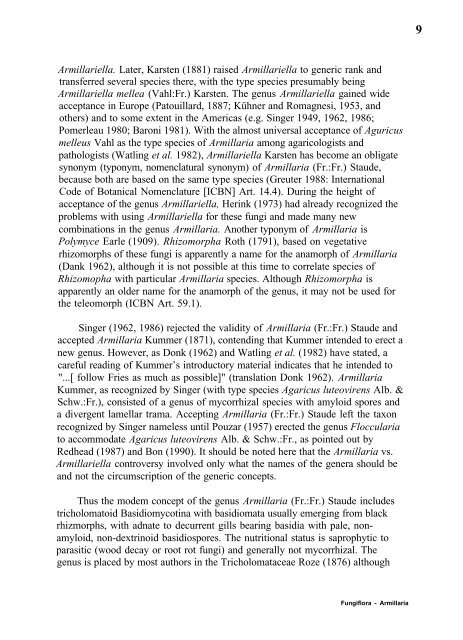A Nomenclatural Study of Armillaria and Armillariella species
A Nomenclatural Study of Armillaria and Armillariella species
A Nomenclatural Study of Armillaria and Armillariella species
Create successful ePaper yourself
Turn your PDF publications into a flip-book with our unique Google optimized e-Paper software.
<strong>Armillariella</strong>. Later, Karsten (1881) raised <strong>Armillariella</strong> to generic rank <strong>and</strong><br />
transferred several <strong>species</strong> there, with the type <strong>species</strong> presumably being<br />
<strong>Armillariella</strong> mellea (Vahl:Fr.) Karsten. The genus <strong>Armillariella</strong> gained wide<br />
acceptance in Europe (Patouillard, 1887; Kühner <strong>and</strong> Romagnesi, 1953, <strong>and</strong><br />
others) <strong>and</strong> to some extent in the Americas (e.g. Singer 1949, 1962, 1986;<br />
Pomerleau 1980; Baroni 1981). With the almost universal acceptance <strong>of</strong> Aguricus<br />
melleus Vahl as the type <strong>species</strong> <strong>of</strong> <strong>Armillaria</strong> among agaricologists <strong>and</strong><br />
pathologists (Watling et al. 1982), <strong>Armillariella</strong> Karsten has become an obligate<br />
synonym (typonym, nomenclatural synonym) <strong>of</strong> <strong>Armillaria</strong> (Fr.:Fr.) Staude,<br />
because both are based on the same type <strong>species</strong> (Greuter 1988: International<br />
Code <strong>of</strong> Botanical Nomenclature [ICBN] Art. 14.4). During the height <strong>of</strong><br />
acceptance <strong>of</strong> the genus <strong>Armillariella</strong>, Herink (1973) had already recognized the<br />
problems with using <strong>Armillariella</strong> for these fungi <strong>and</strong> made many new<br />
combinations in the genus <strong>Armillaria</strong>. Another typonym <strong>of</strong> <strong>Armillaria</strong> is<br />
Polymyce Earle (1909). Rhizomorpha Roth (1791), based on vegetative<br />
rhizomorphs <strong>of</strong> these fungi is apparently a name for the anamorph <strong>of</strong> <strong>Armillaria</strong><br />
(Dank 1962), although it is not possible at this time to correlate <strong>species</strong> <strong>of</strong><br />
Rhizomopha with particular <strong>Armillaria</strong> <strong>species</strong>. Although Rhizomorpha is<br />
apparently an older name for the anamorph <strong>of</strong> the genus, it may not be used for<br />
the teleomorph (ICBN Art. 59.1).<br />
Singer (1962, 1986) rejected the validity <strong>of</strong> <strong>Armillaria</strong> (Fr.:Fr.) Staude <strong>and</strong><br />
accepted <strong>Armillaria</strong> Kummer (1871), contending that Kummer intended to erect a<br />
new genus. However, as Donk (1962) <strong>and</strong> Watling et al. (1982) have stated, a<br />
careful reading <strong>of</strong> Kummer’s introductory material indicates that he intended to<br />
"...[ follow Fries as much as possible]" (translation Donk 1962). <strong>Armillaria</strong><br />
Kummer, as recognized by Singer (with type <strong>species</strong> Agaricus luteovirens Alb. &<br />
Schw.:Fr.), consisted <strong>of</strong> a genus <strong>of</strong> mycorrhizal <strong>species</strong> with amyloid spores <strong>and</strong><br />
a divergent lamellar trama. Accepting <strong>Armillaria</strong> (Fr.:Fr.) Staude left the taxon<br />
recognized by Singer nameless until Pouzar (1957) erected the genus Floccularia<br />
to accommodate Agaricus luteovirens Alb. & Schw.:Fr., as pointed out by<br />
Redhead (1987) <strong>and</strong> Bon (1990). It should be noted here that the <strong>Armillaria</strong> vs.<br />
<strong>Armillariella</strong> controversy involved only what the names <strong>of</strong> the genera should be<br />
<strong>and</strong> not the circumscription <strong>of</strong> the generic concepts.<br />
Thus the modem concept <strong>of</strong> the genus <strong>Armillaria</strong> (Fr.:Fr.) Staude includes<br />
tricholomatoid Basidiomycotina with basidiomata usually emerging from black<br />
rhizmorphs, with adnate to decurrent gills bearing basidia with pale, nonamyloid,<br />
non-dextrinoid basidiospores. The nutritional status is saprophytic to<br />
parasitic (wood decay or root rot fungi) <strong>and</strong> generally not mycorrhizal. The<br />
genus is placed by most authors in the Tricholomataceae Roze (1876) although<br />
Fungiflora - <strong>Armillaria</strong><br />
9

















